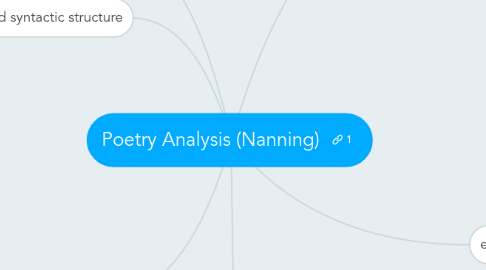
1. semantic structure
1.1. imagery
1.1.1. metaphor
1.1.2. metonymy
1.1.2.1. synecdoche
1.1.3. synaesthesia
1.1.4. isotopy
2. morphological and syntactic structure
2.1. rhetorical figures
2.1.1. morphological
2.1.2. syntactic
2.1.3. semantic
2.1.4. pragmatic
2.2. word repetition
2.3. poetic syntax
3. phonetic structure
3.1. Rhyme
3.1.1. position in line
3.1.1.1. end-rhyme
3.1.1.2. internal rhyme
3.1.2. number of syllables
3.1.2.1. masculine/monosyllabic
3.1.2.2. feminine/disyllabic
3.1.2.3. triple
3.1.3. purity/extensiveness
3.1.3.1. full
3.1.3.2. more
3.1.3.2.1. rich
3.1.3.2.2. identical
3.1.3.3. less
3.1.3.3.1. end assonance/vowel rhyme
3.1.3.3.2. consonance
3.1.3.3.3. pararhyme
3.1.3.3.4. eye/sight rhyme
3.1.3.3.5. historical rhyme
3.1.4. division of syllables
3.1.4.1. mosaic rhyme
3.1.4.2. broken rhyme/split rhyme
3.2. Alliteration
4. speech situation
4.1. communication model
4.1.1. speaker
4.1.1.1. lyric persona
4.1.1.2. subjectivity
4.1.1.2.1. implicit
4.1.1.2.2. explicit
4.1.1.3. not author
4.1.2. addressee
4.1.2.1. lyric thou
4.1.2.2. not reader
4.1.3. where are they situated?
4.2. pragmatic figures
4.2.1. apostrophe
4.2.2. rhetorical question
4.3. levels
4.3.1. enounced
4.3.1.1. What?
4.3.2. enunciation
4.3.2.1. How?
4.4. spatio-temporal distance
4.4.1. unmediated poem
4.4.2. mediated poem
5. external form
5.1. stanza
5.2. line
5.2.1. enjambment
5.2.2. caesura
5.2.2.1. alexandrine
5.2.2.1.1. iambic hexameter
5.2.2.1.2. caesura after the third stress
6. rhythm
6.1. foot
6.1.1. iamb
6.1.1.1. unstressed-stressed
6.1.2. trochee
6.1.2.1. stressed-unstressed
6.1.3. dactyl
6.1.3.1. stressed-unstressed-unstressed
6.1.4. anapest
6.1.4.1. unstressed-unstressed-stressed
6.2. meter
6.2.1. trimeter
6.2.2. tetrameter
6.2.3. pentameter
6.2.4. hexameter

